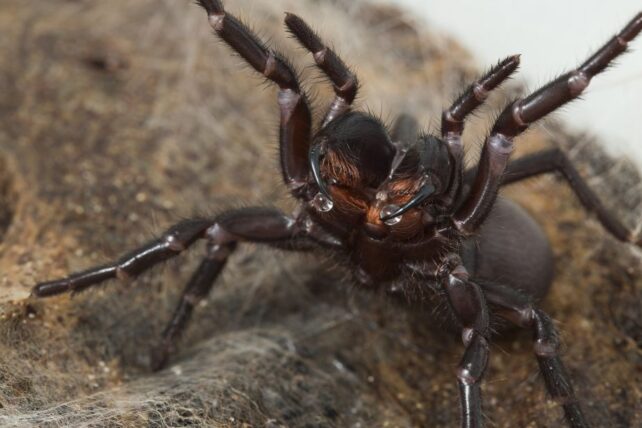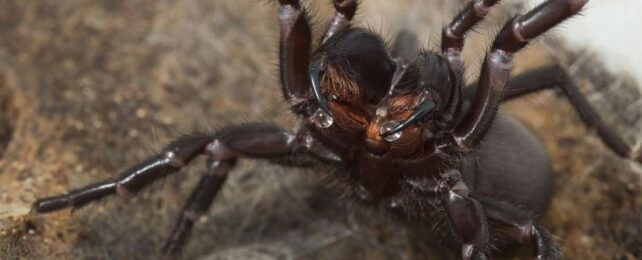The potent cocktail of toxins in the venom of one of the world's deadliest spiders seems to vary depending on context.
A new analysis of how funnel-web spiders produce their venom shows that factors such as the spider's heart rate and defensiveness could play a role in the proportions of chemicals delivered on the ends of the fangs of an angry arachnid.
Why do we want to know? Because funnel-web spiders' venoms are complex mixtures with a range of potential applications, such as natural pesticides and pharmaceuticals – not to mention the antivenom used to treat the spiders' deadly bites. Understanding why funnel-webs produce these mixtures could aid in more efficient venom milking and use and help us figure out the function of the venom.
"Funnel-webs have the most complex venoms in the natural world, and they are valued for the therapeutics and natural bioinsecticides that are potentially hidden in their venom molecules," explains biologist Linda Hernández Duran of James Cook University in Australia.
"Knowing more about how they are produced is a step towards unlocking this potential."
We've conducted a lot of research on funnel-web venom, which is deadly only to the insects it preys upon and, due to some weird quirk of evolution, primates.
Australian funnel-web spiders are famous for being the deadliest (to humans, anyway) in the world, although it may comfort you to know that, although 30 to 40 people are bitten every year, only the male Sydney funnel-web has killed people, and there have been no funnel-web deaths since an antivenom was introduced in 1981.
However, while a lot of work has been done to understand the molecular complexity of the venom, these studies have not considered the spiders's behavior, physical state, and environment. So Hernández Duran and her colleagues set out to investigate.

They collected specimens of four species of Australian funnel-web spiders – Border Ranges (Hadronyche valida), Darling Downs (Hadronyche infensa), Southern tree-dwelling (Hadronyche cerberea), and Sydney (Atrax robustus) funnel-webs. These spiders were then subjected to several annoying tests.
The tests assessed huddling, defensive, climbing, and generally active behavior in three different contexts. The first was predation, which the scientists mimicked by blowing puffs of air or prodding the spiders with tweezers. The second was hanging out with another spider of the same species. And the third was the exploration of a new territory.
During these tests, researchers "mapped [the spiders'] behavior and measured their heart rate with a laser monitor to establish a proxy value for their metabolic rate. We then collected their venom and analyzed it with a mass spectrometer," Hernández Duran says.
For three species, there seemed to be no association between their behavior and heart rate and the composition of their venom. However, scientists noticed a difference for one spider: a higher heart rate and defensiveness in the Border Ranges funnel-web seemed to be associated with a varying venom composition.
The fact that the three other species didn't demonstrate the same association between venom composition and physical factors suggests that these associations might be species-specific. We just don't know what those associations might be for the other species yet.
The research made another connection, too. We know that the production of venom and the aggressive displays made by cranky funnel-webs do have metabolic costs. The team's work suggests that funnel-web spiders may make behavioral trade-offs to compensate for these, increasing their metabolic rate to produce venom and reducing their movement when under threat.
Other strategies could involve adjusting the number of bites, modulating venom quantity, and making aggressive displays without deploying a venomous bite.
The results, the researchers say, could be helpful for antivenom production and the study of bioactive components found in funnel-web venoms.
"We showed for the first time how specific venom components are associated with particular behavioral and physiological variables and demonstrated that these relationships are context-dependent," Hernández Duran says.
"We gained some valuable insights for further exploration and understanding of the ecological role of venom."
The research has been published in PLOS ONE.
